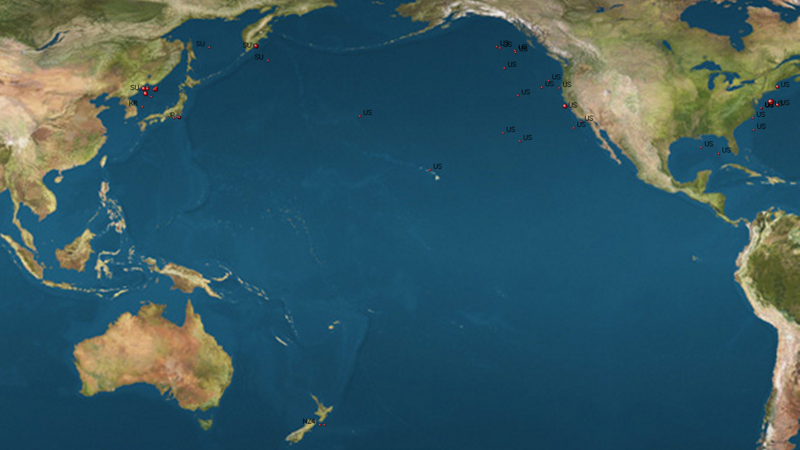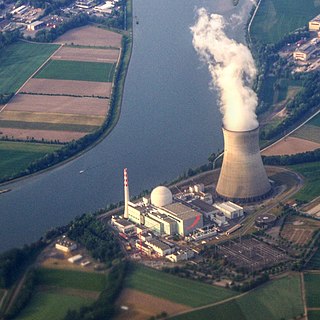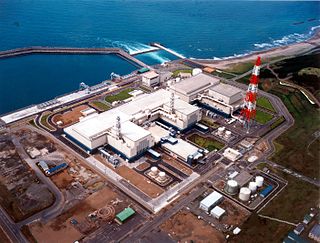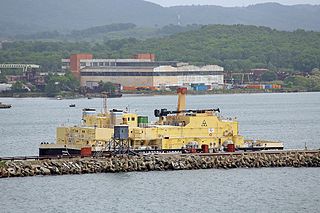1946–1993
Data are from IAEA-TECDOC-1105. [2] Summary of pages 27–120:
Disposal projects attempted to locate ideal dumping sites based on depth, stability and currents, and to treat, solidify and contain the waste. However, some dumping only involved diluting the waste with surface water, or used containers that imploded at depth. Even containers that survived the pressure could physically decay over time.

The countries involved – listed in order of total contributions measured in TBq (TBq=1012 becquerel) – were the Soviet Union, the United Kingdom, Switzerland, the United States, Belgium, France, the Netherlands, Japan, Sweden, Russia, New Zealand, Germany, Italy and South Korea. Together, they dumped a total of 85,100 TBq (85.1x1015 Bq) of radioactive waste at over 100 ocean sites, as measured in initial radioactivity at the time of dump.
For comparison:
- Global fallout of nuclear weapon tests – 2,566,087x1015 Bq. [5]
- 1986 Chernobyl disaster total release – 12,060x1015 Bq. [6]
- 2011 Fukushima Daiichi nuclear disaster, estimated total 340x1015 to 780x1015 Bq, with 80% falling into the Pacific Ocean. [7]
- Fukushima Daiichi nuclear plant cooling water dumped (leaked) to the sea – TEPCO estimate 4.7x1015 Bq, Japanese Nuclear Safety Commission estimate 15x1015 Bq, [8] French Nuclear Safety Committee estimate 27x1015 Bq. [9]
- Naturally occurring Potassium 40 in all oceans – 14,000,000x1015 Bq. [10]
- One container (net 400 kg) of vitrified high-level radioactive waste has an average radioactivity of 4x1015 Bq (Max 45x1015 Bq).
| Country | dumped (unit TBq=1012 Bq) | period | num of sites, volume, etc.* | |||
|---|---|---|---|---|---|---|
| Arctic | Atlantic | Pacific | Total | |||
| 38,369 | 0 | 874 | 39,243 | 1959–1992 [11] | Arctic 20 sites, 222,000 m3 and reactor w or w/o spent fuel; Pacific Ocean (mainly sea of Japan) 12 sites, 145,000 m3 | |
| 0 | 35,088 | 0 | 35,088 | 1948–82 | NE Atlantic 15 sites, unknown number of containers, 74,052 tons and 18 sites off coast of British isles more than 9.4 TBq | |
| 0 | 4,419 | 0 | 4,419 | 1969–1982 | NE Atlantic 3 sites, 7,420 containers, 5,321 tons | |
| 0 | 2,942 | 554 | 3,496 | 1946–70 | Mid/NW Atlantic (9), Gulf of Mexico (2) total 11 sites, 34,282 containers, unknown quantity; Mid/NE Pacific Ocean, total of 18 sites, 56,261 containers, ? tones | |
| 0 | 2,120 | 0 | 2,120 | 1960–1982 | NE Atlantic 6 sites, 55,324 containers, 23,100 tons | |
| 0 | 354 | 0 | 354 | 1967–1969 | NE Atlantic 2 sites, 46,396 containers, 14,300 tons | |
| 0 | 336 | 0 | 336 | 1967–1982 | NE Atlantic 4 sites, 28,428 containers, 19,200 tons | |
| 0 | 0 | 15.08 | 15.08 | 1955–1969 | South of Honshu, 6 sites 15 times, 3,031 containers, 606,000 m3 | |
| 0 | 3.2 | 0 | 3.2 | 1959,61,69 | Baltic sea 1 site, 230 containers, 64 tons; NE Atlantic 1 site, 289.5 containers, 1,080 tons, | |
| 0.7 | 0 | 2.1 | 2.8 | 1992–93 | Arctic 3,066 m3; Pacific Ocean 6,327 m3 | |
| 0 | 0 | 1.04 | 1.04 | 1954–1976 | East coast of New Zealand, 4 sites, 9 containers, 0.62 m3 | |
| 0 | 0.2 | 0 | 0.2 | 1967 | NE Atlantic 1 site once, 480 containers, 185 tons | |
| 0 | 0.2 | 0 | 0.2 | 1969 | NE Atlantic 1 site, 100 containers, 45 tons | |
| 0 | 0 | no data | 1968–1972 | Sea of Japan, 1 site 5 times?, 115 container, 45 tons | ||
| Total | 38,369 | 45,262 | 1,446 | 85,077 | Subtotal of all volume reported is 982,394 m3. | |
| *Some countries report the mass and volume of disposed waste and some just tonnage. The US did not report tonnage or volume of 90,543 containers. | ||||||
Types of waste and packaging
Data are from IAEA-TECDOC-1105. [2] : 6–7, 14
Liquid waste
- unpackaged and diluted in surface waters
- contained in package but not solidified
Solid waste
Reactor vessels
- without nuclear fuel
- containing damaged spent nuclear fuel solidified with polymer agent
- special container with damaged spent nuclear fuel (icebreaker Lenin by the former Soviet Union)
| Waste type | Atlantic | Pacific Ocean | Arctic | total | note |
|---|---|---|---|---|---|
| Reactors with spent fuel | Nil | Nil | 36,876 | 36,876 | |
| Reactors w/o fuel | 1,221 | 166 | 143 | 1,530 | |
| Low level solid | 44,043 | 821 | 585 | 45,449 | |
| Low level liquid | <0.001 | 459 | 765 | 1,223 | |
| Total | 45,264 | 1445 | 38,369 | 85,078 |
Dump sites
Data are from IAEA-TECDOC-1105. [2] : 27–120 There are three dump sites in the Pacific Ocean.
Arctic
Mainly at the east coast of Novaya Zemlya at Kara Sea and relatively small proportion at Barents Sea by the Soviet Union. Dumped at 20 sites from 1959 to 1992, [11] total of 222,000 m3 including reactors and spent fuel.

North Atlantic
Dumping occurred from 1948 to 1982. The UK accounts for 78% of dumping in the Atlantic (35,088 TBq), followed by Switzerland (4,419 TBq), the United States (2,924 TBq) and Belgium (2,120 TBq). Sunken Soviet nuclear submarines are not included; see List of sunken nuclear submarines
There were 137,000 tonnes dumped by eight European countries. The United States reported neither tonnage nor volume for 34,282 containers.

Pacific Ocean
The Soviet Union 874 TBq, US 554 TBq, Japan 606.2 Tonnes, New Zealand 1+ TBq. 751,000 m3 was dumped by Japan and the Soviet Union. The United States reported neither tonnage nor volume of 56,261 containers.
Dumping of contaminated water at the 2011 Fukushima nuclear accident (estimate 4,700–27,000 TBq) is not included.

Sea of Japan
The Soviet Union dumped 749 TBq. Japan dumped 15.1 TBq south of main island. South Korea dumped 45 tonnes (unknown radioactivity value).

















